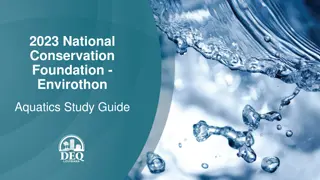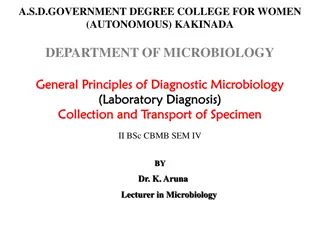Adaptations of Aquatic Specimens, with a Focus on Sea Snakes
Aquatic specimens, particularly sea snakes of the subfamily Hydrophiinae, exhibit fascinating adaptations for their fully aquatic lifestyle. These marine snakes are uniquely adapted for life in the sea, with specialized features such as paddle-like tails, compressed bodies, and the ability to respire through their skin. They face challenges distinct from terrestrial animals and have evolved traits like thicker skin to thrive in their underwater habitats, primarily found in Indo-Australian and Southeast Asian waters.
Download Presentation

Please find below an Image/Link to download the presentation.
The content on the website is provided AS IS for your information and personal use only. It may not be sold, licensed, or shared on other websites without obtaining consent from the author.If you encounter any issues during the download, it is possible that the publisher has removed the file from their server.
You are allowed to download the files provided on this website for personal or commercial use, subject to the condition that they are used lawfully. All files are the property of their respective owners.
The content on the website is provided AS IS for your information and personal use only. It may not be sold, licensed, or shared on other websites without obtaining consent from the author.
E N D
Presentation Transcript
Aquatic Aquatic specimens specimens adaptations adaptations
Hydrophis Kingdom: Animalia Phylum: Chordata Class: Reptilia Order: Squamata Suborder: Serpentes Family: Elapidae Subfamily: Hydrophiinae Genus: Hydrophis
Habitat / Food source Sea snakes, or coral reef snakes, are a subfamily of venomous elapid snakes, the Hydrophiinae, that inhabit marine environments for most or all of their lives. Most are extensively adapted to a fully aquatic life and are unable to move on land. They feed on small fish and occasionally young octopus.
They are typically found in Indo-Australian and Southeast Asian waters. Currently, around 36 species are recognized. Most species of sea snakes are able to respire through the top of their skin.
Habitat / Food source An aquatic animal faces challenges not encountered by its terrestrial counterparts, promoting adaptive responses in multiple traits. For example, a thicker dermis might protect snakes when they are pushed against sharp objects by water currents, and might enable a snake to shed fouling organisms attached to its skin. We thus predicted that marine snakes should have thicker skin than terrestrial species.
Live mainly in waters less than 30 metres (about 100 feet) deep, as they must dive to the seafloor to obtain their food among coral reefs, among mangroves, or on the ocean bottom. Some species prefer hard bottoms (corals), while others prefer soft bottoms (mud or sand) in which to hunt their prey. Most sea snakes feed upon fishes of various sizes and shapes, including eels. Hydrophis specializes in burrowing eels.
Body structure sea snake have paddle-like tails and laterally compressed body that give them an eel-like appearance. Unlike fish, they do not have gills and must surface regularly to breathe. Most sea snakes are completely aquatic and have adapted to sea environments in many ways, the most characteristic of which is a paddle-like tail that has improved their swimming ability.
This has often caused the ventral scales to become reduced in size, even difficult to distinguish from the adjoining scales. Their lack of ventral scales means they have become virtually helpless on land, but as they live out their entire lifecycles at sea, they have no need to leave the water.
Auatic adaptation features In adaptation to marine life, true sea snakes have a flattened body with a short tail, valvular nostrils on top of the snout, and elongated lungs that extend the entire length of the body. Their scales are very small and usually not overlapping (juxtaposed), abutting against one another like paving stones. The belly scales are reduced in size in the primitive species, whereas in the more advanced forms they are absent.
As a result, the advanced species cannot crawl and are thus helpless on land. When swimming, a keel is formed along part of the belly, increasing surface area and aiding propulsion, which occurs by lateral undulation. Sea snakes can remain submerged for several hours, possibly as much as eight or more. This remarkable feat is partly due to the fact that they can breathe through their skin.
More than 90 percent of waste carbon dioxide and 33 percent of their oxygen requirement can be transported via cutaneous respiration. Moreover, a 2019 study of the blue-banded sea snake (or annulated sea snake, Hydrophis cyanocinctus) found a highly vascularized area between the snout and the top of the head, which allows oxygen to be transported directly from the water to the snake s brain.
Labeo Kingdom: Animalia Phylum: Chordata Class: Actinopterygii Order: Cypriniformes Family: Cyprinidae Subfamily: Labeoninae Genus: Labeo
Habitat / Food source Labeo family Cyprinidae. They are found in freshwater habitats in the tropics and subtropics of Africa and Asia. is a genus of carps in the
Body structure Labeos are larger, and have a more spindle- shaped body, as they are mostly free- swimming. Their mouths look very different, too; they have a pronounced rostral cap, which covers the upper lip except when feeding.
The lips are expanded into thick, sausage- shaped pads which have keratinized edges. The genus name Labeo is Latin for "one who has large lips".























